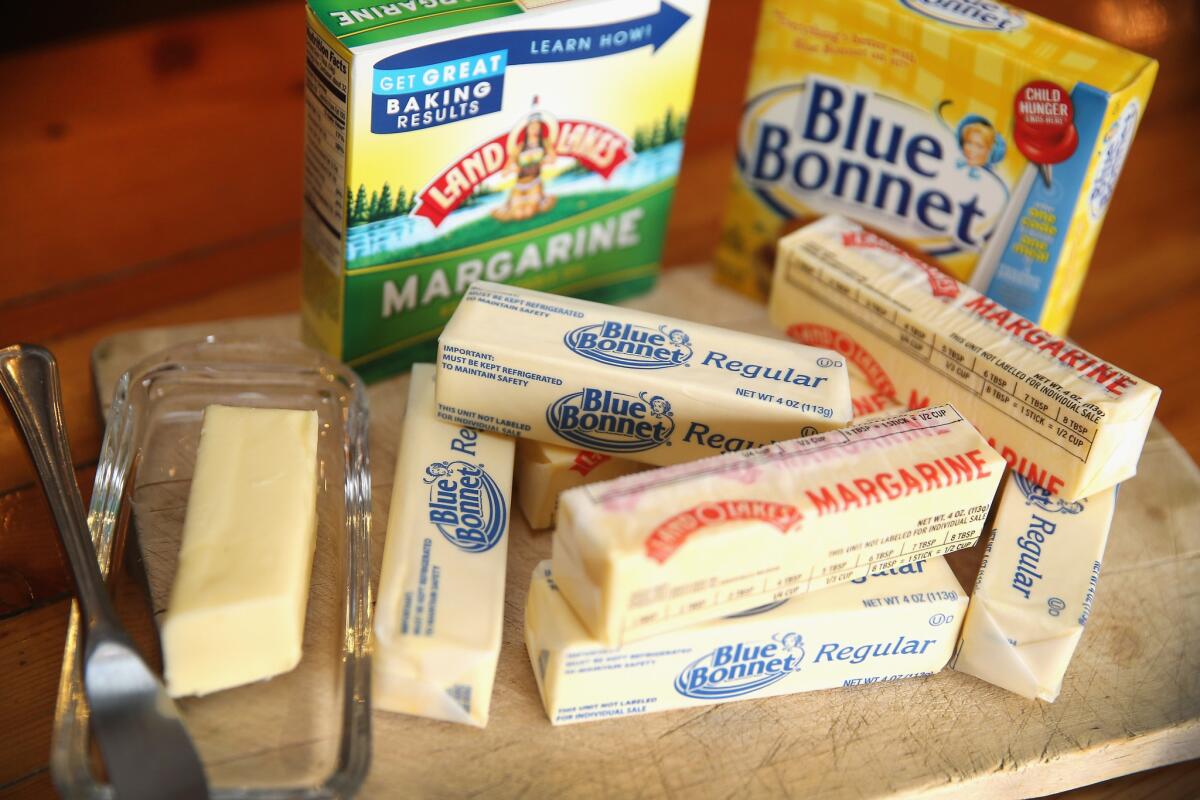FDA bans trans fats in the U.S.: Which foods have them

Stick margarine and other food items which contain trans fat are shown in Chicago, Illinois. The FDA announced it has banned partially hydrogenated oils from the U.S. food supply.
The U.S. Food and Drug Administration announced Tuesday that partially hydrogenated oils (PHOs), the primary dietary source of artificial trans fat in processed foods, must be removed from all food products in the United States within the next three years. “Based on a thorough review of the scientific evidence,” the agency says, PHOs are not “generally recognized as safe” for use in human food.
“The FDA’s action on this major source of artificial trans fat demonstrates the agency’s commitment to the heart health of all Americans,” said the FDA’s acting commissioner, Stephen Ostroff, M.D. “This action is expected to reduce coronary heart disease and prevent thousands of fatal heart attacks every year.”
Trans fats linger in an array of processed foods, including packaged cookies and other baked goods, canned frosting and some forms of margarine.
According to the Mayo Clinic, trans fats are commonly found in baked goods (cakes, cookies, pie crusts and crackers); snack foods (potato, corn and tortilla chips, and microwave popcorn); deep-fried foods (French fries, doughnuts and fried chicken); refrigerator dough (canned biscuits, cinnamon rolls, frozen pizza crusts); and creamer and margarine (nondairy coffee creamer and stick margarines). Even eating only small amounts can add up to troubling consumption over time, public health advocates say.
In 2013, the FDA made a tentative determination that artery-clogging PHOs could no longer be considered safe for human consumption.
Manufacturers have been required to include trans fat content information on the Nutrition Facts label of foods since 2006. Between 2003 and 2012, the FDA estimates consumer trans fat consumption decreased about 78%, largely due to the new labeling rule and industry reformulation of foods. However, the agency says that “While trans fat intake has significantly decreased, the current intake remains a public health concern. The Institute of Medicine recommends that consumption of trans fat be as low as possible while consuming a nutritionally adequate diet.”
The compliance period of three years will allow companies to either reformulate products without PHOs and/or petition the FDA to permit specific uses of PHOs. Following the compliance period, no PHOs can be added to human food unless they are otherwise approved by the FDA.
The FDA encourages consumers seeking to reduce trans fat intake to check a food’s ingredient list for partially hydrogenated oils to determine whether or not a product contains PHOs.
Partially hydrogenated oils occur when manufacturers add hydrogen to vegetable oil to make a substance that is solid at room temperature. As recently as 30 years ago, many scientists believed they were healthier than natural saturated fats – remember when margarine was touted as better for you than butter? However, it has been found that PHOs turn into sludge in arteries, lowering “good” HDL cholesterol and raising “bad” LDL cholesterol, leading to heart attacks, strokes and other serious health problems.
Trans fats (in the form of shortening) entered the U.S. food supply in the 1940s and were quickly embraced by food manufacturers. The products, mostly partially hydrogenated soybean oil and cottonseed oil, provided taste and texture and extended the shelf life of fried and baked foods. They were also cheaper than animal-based fats such as butter and lard.
Some of the country’s largest restaurant chains, including McDonald’s, Taco Bell, Chick-fil-A and Dunkin Donuts, have already removed trans fats from their menu items.
In an economic analysis published Tuesday, the FDA estimated that the new PHO regulations could cost the food industry at least $6 billion over the next 20 years, but that the savings from reduced medical care and other benefits during the same period could exceed $130 billion.
More to Read
Eat your way across L.A.
Get our weekly Tasting Notes newsletter for reviews, news and more.
You may occasionally receive promotional content from the Los Angeles Times.






